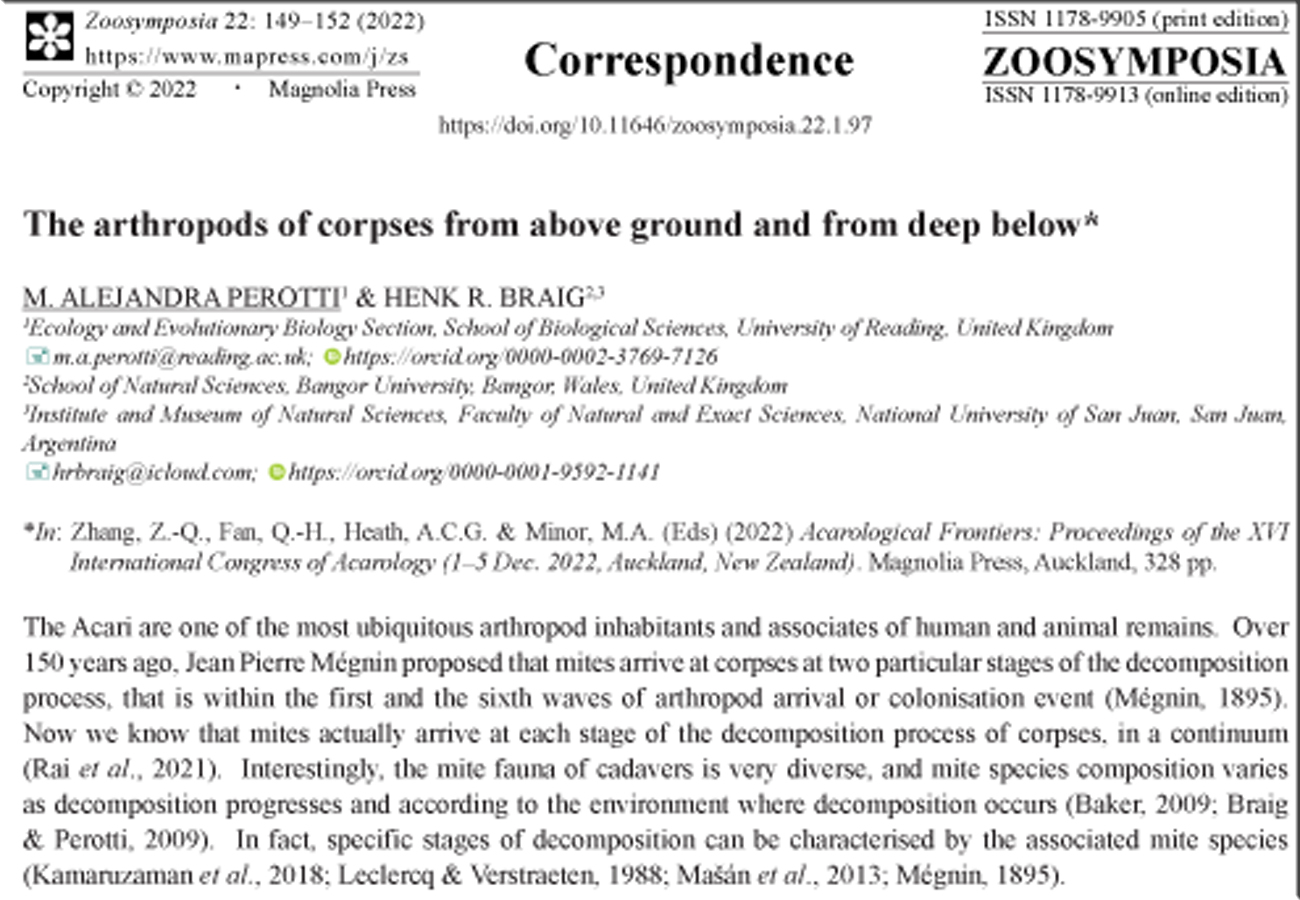Abstract
The Acari are one of the most ubiquitous arthropod inhabitants and associates of human and animal remains. Over 150 years ago, Jean Pierre Mégnin proposed that mites arrive at corpses at two particular stages of the decomposition process, that is within the first and the sixth waves of arthropod arrival or colonisation event (Mégnin, 1895). Now we know that mites actually arrive at each stage of the decomposition process of corpses, in a continuum (Rai et al., 2021). Interestingly, the mite fauna of cadavers is very diverse, and mite species composition varies as decomposition progresses and according to the environment where decomposition occurs (Baker, 2009; Braig & Perotti, 2009). In fact, specific stages of decomposition can be characterised by the associated mite species (Kamaruzaman et al., 2018; Leclercq & Verstraeten, 1988; Mašán et al., 2013; Mégnin, 1895).
References
Arriaza, B., Cartmell, L.L., Moragas, C., Nerlich, A.G., Salo, W., Madden, M. & Aufderheide, A.C. (2008) The bioarchaeological value of human mummies without provenience. Chungara Journal of Chilean Anthropology, 40, 55–65. https://doi.org/10.4067/S0717-73562008000100006
Baker, A.S. (2009) Acari in archaeology. Experimental and Applied Acarology, 49, 147–160. https://doi.org/10.1007/s10493-009-9271-1
Braig, H.R. & Perotti, M.A. (2009) Carcasses and mites. Experimental and Applied Acarology, 49, 45–84. https://doi.org/10.1007/s10493-009-9287-6
Brown, A.G. (2006) The use of forensic botany and geology in war crimes investigations in NE Bosnia. Forensic Science International, 163, 204–210. https://doi.org/10.1016/j.forsciint.2006.05.025
Byrd, J.H. & Castner, J.L. (2009) Forensic Entomology: The Utility of Arthropods in Legal Investigations (Second edition ed.). CRC Press, Boca Raton, 705 pp.
Cox, M., Flavel, A., Hanson, I., Laver, J. & Wesling, R. (2014) The scientific investigation of mass graves: towards protocols and standard operating procedures. Cambridge University Press, Cambridge, 594 pp.
Frost, C.L., Braig, H.R., Amendt, J. & Perotti, M.A. (2010) Indoor arthropods of forensic importance. In: C. C. Amendt J, Grassberger M and Goff ML (Ed), Current Concepts in Forensic Entomology: Novel Arthropods, Environments and Geographical Regions. Springer, Amsterdam, pp. 93–108. https://doi.org/10.1007/978-1-4020-9684-6_6
Hani, M., Thieven, U. & Perotti, M.A. (2018) Soil bulb mites as trace evidence for the location of buried money. Forensic Science International, 292, E25–E30. https://doi.org/10.1016/j.forsciint.2018.09.016
Kamaruzaman, N.A.C., Masan, P., Velasquez, Y., Gonzalez-Medina, A., Lindstrom, A., Braig, H.R. & Perotti, M.A. (2018) Macrocheles species (Acari: Macrochelidae) associated with human corpses in Europe. Experimental and Applied Acarology, 76, 453–471. https://doi.org/10.1007/s10493-018-0321-4
Klimov, P.B., O’Connor, B., O’choa, R., Bauchan, G.R., Redford, A.J. & Scher, J. (2016) Bee Mite ID: Bee-Associated Mite Genera of the World. In. USDA APHIS Identification Technology Program (ITP), Fort Collins, CO. Availbale from: https://idtools.org/id/mites/beemites/ (last accessed: 28 Oct. 2022).
Lambiase, S. & Perotti, M.A. (2019) Using human head lice to unravel neglect and cause of death. Parasitology, 146, 678–684. https://doi.org/10.1017/S0031182018002007
Leclercq, M. & Verstraeten, C. (1988) Entomologie et médecine légale. Datation de la mort. Acariens trouvés sur des cadavres humains [Entomology and forensic medicine. Determination of the time of death. Acari found on human cadavers]. Bulletin et Annales de la Société Royale belge d’Entomologie, 124, 195–200.
Mašán, P., Perotti, M.A., Saloña-Bordas, M.I. & Braig, H.R. (2013) Proctolaelaps euserratus, an ecologically unusual melicharid mite (Acari, Mesostigmata) associated with animal and human decomposition. Experimental and Applied Acarology, 61, 415–429. https://doi.org/10.1007/s10493-013-9710-x
McNemee, R.B., Sames, W.J. & Maloney, F.A. (2003) Occurrence of Dermacentor variabilis (Acari: Ixodidae) around a porcupine (Rodentia: Erthethizontidae) carcass at Camp Ripley, Minnesota. Journal of Medical Entomology, 40, 108–111. https://doi.org/10.1603/0022-2585-40.1.108
Mégnin, P. (1895) La faune des cadavres [The fauna of carcasses]. Annales d’HygieÌne Publique et de Meìdecine Leìgale, série 3, 33, 64–67.
OConnor, B.M. (2009) Astigmatid mites (Acari: Sarcoptiformes) of forensic interest. Experimental and Applied Acarology, 49, 125–133. https://doi.org/10.1007/s10493-009-9270-2
Perotti, M.A. & Braig, H.R. (2009) Phoretic mites associated with animal and human decomposition. Experimental and Applied Acarology, 49, 85–124. https://doi.org/10.1007/s10493-009-9280-0
Perotti, M.A. & Braig, H.R. (2020) Acarology in crimino-legal investigations. In: Byrd, J.H. & Tomberlin, J.K. (Eds), Forensic entomology. The utility of arthropodos in legal investigations. CRC Press, Boca Raton, pp. 461–474. https://doi.org/10.4324/9781351163767-22
Perotti, M.A., Braig, H.R. & Goff, M.L. (2010) Phoretic mites and carcasses. In: Amendt, J. Campobasso, C.P., Grassberger, M. & Goff, M.L. (Eds), Current Concepts in Forensic Entomology: Novel Arthropods, Environments and Geographical Regions. Springer, Amsterdam, pp. 69–91. https://doi.org/10.1007/978-1-4020-9684-6_5
Pimsler, M.L., Owings, C.G., Sanford, M.R., OConnor, B.M., Teel, P.D., Mohr, R.M. & Tomberlin, J.K. (2016) Association of Myianoetus muscarum (Acari: Histiostomatidae) with Synthesiomyia nudiseta (Wulp) (Diptera: Muscidae) on human remains. Journal of Medical Entomology, 53, 290–295. https://doi.org/10.1093/jme/tjv203
Rai, J.K., Amendt, J., Bernhardt, V., Pasquerault, T., Lindstrom, A. & Perotti, M.A. (2020) Mites (Acari) as a relevant tool in trace evidence and postmortem analyses of buried corpses. Journal of Forensic Sciences, 65, 2174–2183. https://doi.org/10.1111/1556-4029.14506
Rai, J.K., Pickles, B.J. & Perotti, M.A. (2021) Assemblages of Acari in shallow burials: mites as markers of the burial environment, of the stage of decay and of body-cadaver regions. Experimental and Applied Acarology, 85, 247–276. https://doi.org/10.1007/s10493-021-00663-x
Rai, J.K., Pickles, B.J. & Perotti, M.A. (2022) The impact of the decomposition process of shallow graves on soil mite abundance. Journal of Forensic Sciences, 67, 605–618. https://doi.org/10.1111/1556-4029.14906
Russell, D.J., Schulz, M.M. & OConnor, B.M. (2004) Mass occurRence of astigmatid mites on human remains. Abhandlungen und Berichte des Naturkundemuseums Görlitz, 76, 51–56.
Salona-Bordas, M.I., Bahillo de la Puebla, P., Diaz Martin, B., Sumner, J. & Perotti, M.A. (2015) Ixodes ricinus (Ixodidae), an occasional phoront on necrophagous and coprophagous beetles in Europe. Experimental and Applied Acarology, 65, 243–248. https://doi.org/10.1007/s10493-014-9867-y
Saloña-Bordas, M.I., Moraza, M.L., Carles-Tolrá, M., Iraola, V., Bahillo, P., Yélamos, T., Outerelo, R. & Alcaraz, R. (2010) Searching the soil: Forensic importance of edaphic fauna after the removal of a corpse. Journal of Forensic Sciences, 55, 1652–1655. https://doi.org/10.1111/j.1556-4029.2010.01506.x
Solarz, K. (2009) Indoor mites and forensic acarology. Experimental and Applied Acarology, 49, 135–142. https://doi.org/10.1007/s10493-009-9292-9
Szelecz, I., Lösch, S., Seppey, C.V.W., Lara, E., Singer, D., Sorge, F., Tschui, J., Perotti, M.A. & Mitchell, E.A.D. (2018) Comparative analysis of bones, mites, soil chemistry, nematodes and soil micro-Eukaryotes from a suspected homicide to estimate the post-mortem interval. Scientific Reports, 8, 1–14. https://doi.org/10.1038/s41598-017-18179-z


